Drought leaves farmers with massive debt and no crops to harvest
Paddocks are a wasteland, crops will go unharvested and farmers are facing two years without an income. Paul Ashenden visits the epicentre of the state’s drought. Watch the video and see the bleak pictures.
SA News
Don't miss out on the headlines from SA News. Followed categories will be added to My News.
In a normal year, we’d be pushing our way through a thick, lush bean crop that’s waist high and heavy with pods.
Today though, we’re kicking up red dust in a paddock of plants that struggle to come up to our ankles in a scene that wouldn’t be out of place in a region recovering from a bushfire.
We’re at the Mid North property of Ben and Jen Richie, about halfway between Appila and Wirrabara. Their land is about 250km north of Adelaide and part of a region that is experiencing the worst drought in living memory.
So far this year, the Richies have welcomed just 108mm of rain. Their average annual rainfall is somewhere between 350 and 400mm.
The late-afternoon October sun beats down as Ben, 35, and Jen, 34, watch their children Oliver, 7, Chelsea, 5, and Georgia, 2 run around the near-bare paddock, using up their school-holiday energy.
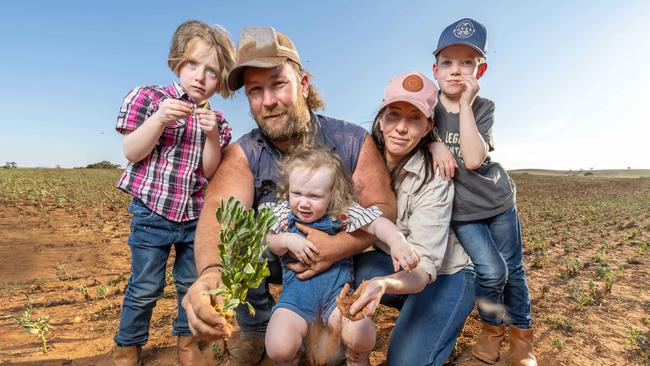
They’re philosophical about their plight, but will be relying on the whim of a bank manager to get through to next year’s harvest after going two years without a cropping income.
They planted nearly 900 hectares of crop this year, at an expense of about $350,000, but won’t make a dollar. The legume crops are a write-off and the barley is so bad they have opened the gates and let their few remaining sheep to feed off it.
Mr Richie is “hoping” to salvage between 10 and 15 per cent of the wheat for seed, so he has something to plant next year. But he’s not confident of even doing that.
Meanwhile, they have had to reduce the merino sheep flock the family has spent years building up from 1350 to 520. There’s just not enough feed to keep all the sheep alive.
“I was talking to a bloke the other day, he was 92 and he said he’s never seen anything like this,” Mr Richie says.
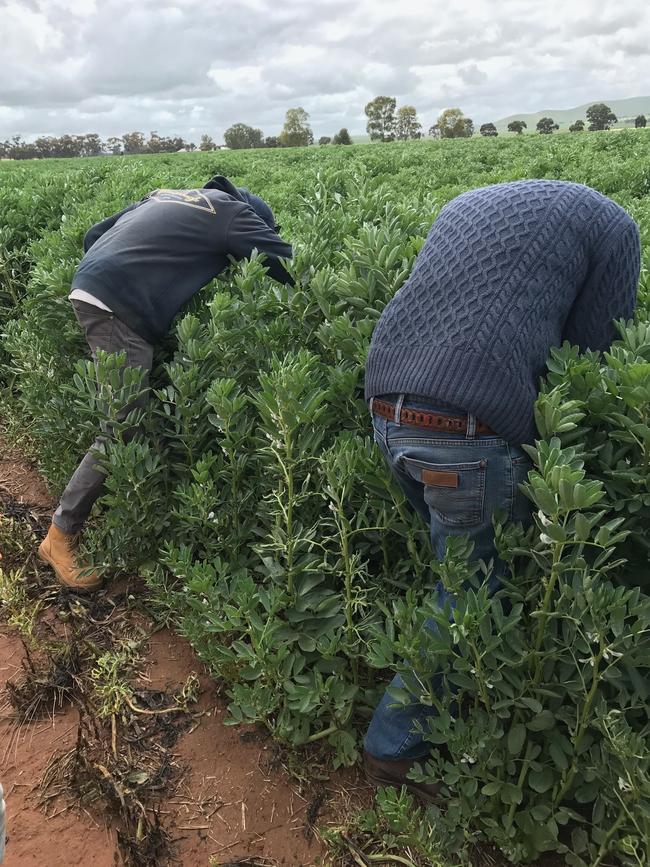
Ms Richie, 12 weeks pregnant with the couple’s fourth child, says the contrast in this paddock to the last good year is stark.
“In 2022, you’d come up the driveway and the beans were up to here,” she says, gesturing to her hip.
“Just the difference between how good of a year 2022 was to now … and it’s not just one pocket of South Australia, it’s the whole of South Australian farmers who are feeling the pressure.
“The agricultural industry is pretty much the backbone of Australia, and it’s crumbling. And governments aren’t doing anything about it.”
“A lot of farmers are now at the point where they’re starting to question whether they can even continue on. And these are fourth and fifth generation farmers. It’s devastating.”
AS BAD AS IT GETS
Broadacre farmers are hurting in all corners of the state. Graziers have forked out hundreds of thousands of dollars in feed and many grain producers won’t even wheel their header out of the shed to harvest.
Grain Producers SA says the state is in drought and most farmers say it’s the worst anyone can remember.
The epicentre of the drought is in the Mid North, where rainfall is at a record low. Barley, beans, wheat, canola and lentil crops are a pathetic shell of what they should be at this time of year.
Some farmers will lose $500,000 because they won’t have a harvest. Some will lose $1m. Some will lose more.
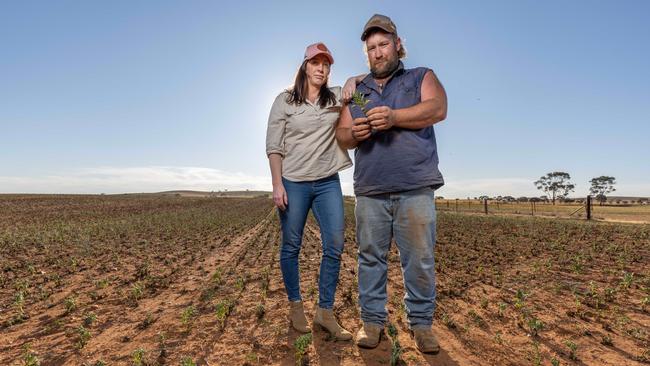
Gladstone’s silo and storage sheds, touted as the largest inland storage facility in Australia, traditionally receives between 400,000 and 450,000 tonnes of grain each harvest. This year, farmers wouldn’t be surprised if less than 10,000 tonnes are delivered.
Mid North farmers are in the process of establishing a grain register so that those fortunate enough to harvest some crop and store the grain will be able to offer any they don’t need next year to their neighbours.
Andrew Zanker, 50, farms about 800 hectares just around the corner from the Richies. The fifth-generation farmer says the Appila was suffering drought conditions last year but this year is “as bad as it gets”.
He has written off 11 of the 15 paddocks he sowed earlier this year and is hopeful, rather than confident, of harvesting anything from the remaining four.
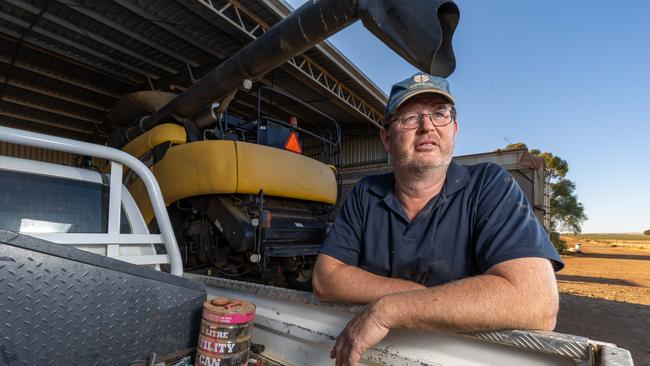
“I don’t think there’s anyone living that’s seen it so dry,” Mr Zanker says. “We haven’t seen it like this before, so we’re in uncharted waters at the moment.
“There are people in very good areas that will barely reap anything. It’s affecting everyone.
“This year is a total hit for me – 100 per cent. It’s basically start again. We’ve just got to load up, cross this year off with a big cross and go again next year.”
Mr Zanker is secretary of a Laura Agricultural Bureau that helped organise a social night earlier this month that attracted 100 farmers who jumped at the opportunity to get together, share stories and look for financial and emotional pathways through this disaster.
MASSIVE FLOW-ON EFFECT
Andrew Kitto, 63, who farms 850 hectares near Gladstone, is also a member of the Laura Ag Bureau. Like everyone else in the region, his finances will go backwards this year and he says one of the keys to surviving will be meetings such as that one earlier this month.
“It gave people hope that they are not alone, and that was the main thing,” he says as he swipes away a fly.
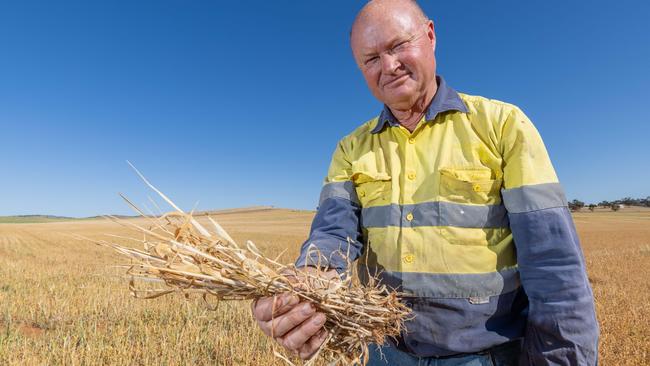
“There were people there that are good farmers that we’ve never seen at meetings before. And they’ve come along, because a lot of farmers are hurting … and it was all about just standing there talking, shoulder to shoulder, about stuff … You’re not alone.”
Mr Kitto is also a contract harvester but his customer numbers have dropped from 30 in 2022 to 20 last year to just five this year, a change he describes as “a huge reduction in income.”
“I think I was probably at the lowest about early August and thinking things aren’t looking too good,” he says when asked about the mental toll of the drought.
“And then it started to filter into town people in the middle of September, when they’re driving around, they didn’t realise how bad it was.

“And things in rural businesses have just dried up – in towns generally, and people have just stopped spending, so it’s affecting not only the farmers but all businesses – machinery and things like that.
“It’s going to be a real big, big blow for them. And it’s just the flow-on effect. We’re trying to get the message out to the government and people in power that things are going to be very crook in the whole of South Australia. Not just this year, but next year as well.”
CROPS ARE ALL DYING
About 50km to the east, Merv Robinson is a month shy of his 80th birthday and says this is the worst year his family has seen since they started farming in the area in 1910.
Mr Robinson, his son Darren, 55, and grandsons Daniel, 25, and Henry, 23, farm more than 3200 hectares just west of Whyte Yarcowie. He’s blunt in his assessment of the year.
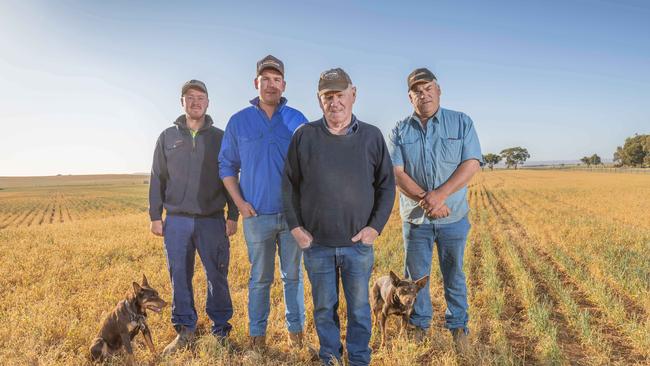
Family records show the farm received about 230mm in 1914 – the year his father always said was the worst year on record. Before now, the worst Mr Robinson could remember is 1967, when they got 265mm. But so far this year, the family farm Aroona has received just 140mm.
“I know we’ve got a couple of months to go, but the crops are all dying,” he says. “It’s pretty crook.”
Across at Narridy, Linden Price, 65, farms on land that has long been recognised as being “as good as it gets” in the Mid North. But even he is not immune to the drought and he shows us through a dusty, yellow wheat crop that should be green and waist-high. He has received about 100mm of rain so far this year – about 170mm less than he usually gets.
“We’re in a seed and salvage situation at the moment,” he says. “We’ve just got to salvage up, get some good seed and then we’ll just stick everything on the farm. We won’t cart any grain anywhere, we’ll just stick it in our own silos.”
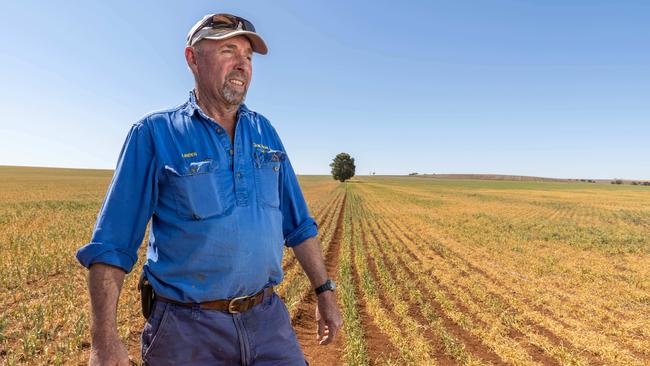
CEREAL GAMBLERS
Peter McCallum, 66, has land just east of Booleroo Centre and we catch up with him as the sun sets behind Mt Remarkable in the Southern Flinders Ranges.
He reckons this will probably be the first in his 50 years of farming that he won’t reap a crop on this property. His biggest fall of rain since January was 12mm in mid-August.
“Since about June, we’ve been told La Nina is coming, it’s going to get wet,” he says. “Every month as they say that, and we’re still waiting. But now I think that when we got to October 1, all of a sudden the realisation was there that the rain’s not going to help.”
He says skyrocketing expenses such as council rates and insurance have added to farmers’ woes. He urges the government to acknowledge the state is in the midst of drought.
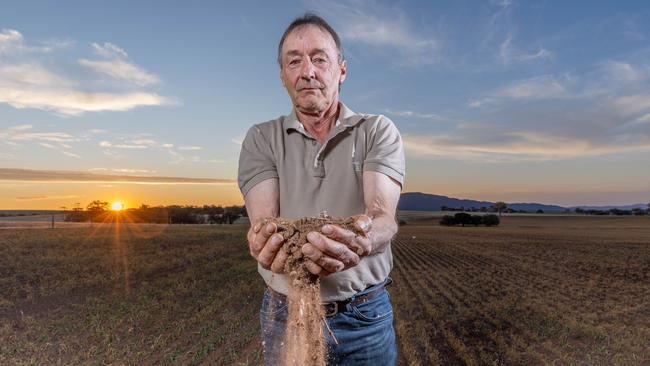
“Most people think farmers are doing all right, but they’re not,” he says as the light fades on another cloud-free day. “Just this fact that you’ve got to put out all that money for no reward, and then you’ve got to do it again the next year.
“I don’t know how long you can keep doing that for … but as I like to say that with news like this, you just need a dry sense of humour.”
Mr McCallum delivers the joke with a chuckle and adds another one-liner about grain producers being cereal gamblers, as if to emphasise the point that humour can play a key role in helping farmers work through these difficult times.
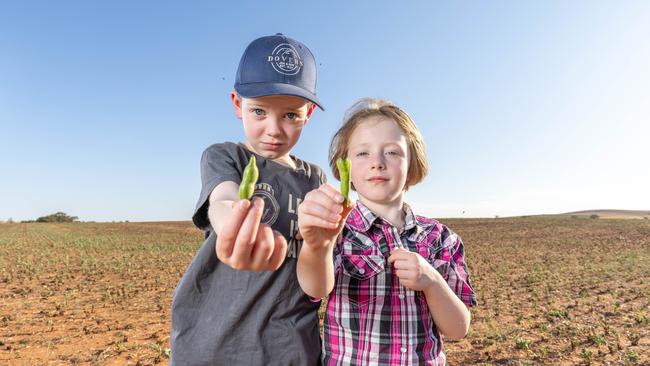
The gambling pun is similar to an analogy delivered by Ben Richie earlier in the day, who told the story of explaining to a city mate that farming was like going to a bank and asking them for half a million dollars, and then going to the casino and putting all that money on red or black on the roulette wheel.
“And that’s just to get your money back,” he told his mate. “Or, if you really want to have a good year as a farmer, you pick a colour and a suit. But if you lose, you go back to the bank again and say ‘I want another half million dollars’. That’s what we do every year.”
More Coverage
Originally published as Drought leaves farmers with massive debt and no crops to harvest





